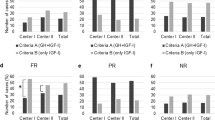Abstract
Purpose
We aimed to evaluate the disease activity of medically controlled patients with acromegaly after withdrawal of somatostatin receptor ligands (SRL).
Methods
Sixteen patients who were on a stable dose of SRL for more than 2 years and had at least 1 year of remission were included in the study. Five patients were on 10 mg, four were on 20 mg and three were on 30 mg of octreotide; whereas for lanreotide, one was on 60 mg, two were on 90 mg, and one was on 120 mg. All patients had received SRL with 28-day intervals. Basal GH, IGF1, glucose-suppressed GH levels were measured with 3-month intervals for a total of 12 months after withdrawal. Sella MRI evaluation was obtained at 6-month intervals. If the nadir GH level after glucose suppression was >1 ng/ml or IGF1 was above the normal limits during the follow-up period, SRL was restarted.
Results
Three months after stopping SRL, 10 (63 %) had biochemical disease recurrence. After 12 months of follow-up, in total 13 (81 %) of the patients recurred. The final basal GH levels before withdrawal, basal GH at month-3, and glucose suppressed GH levels were significantly lower in patients with sustained remission (p = 0.003, p < 0.001, and p = 0.001). Basal GH and glucose suppressed GH levels at month-3 were correlated with the basal GH levels at month-0 (r = 0.6, p = 0.008 and r = 0.5, p = 0.03).
Conclusion
The final GH levels prior to discontinuation of SRL should be taken into consideration in patients with acromegaly in long-term remission. Moreover, the first visit 3 months after withdrawal is critically important for determining the future status of remission.


Similar content being viewed by others
References
Andersen M (2014) Management of endocrine disease: GH excess: diagnosis and medical therapy. Eur J Endocrinol 170(1):R31–R41. doi:10.1530/EJE-13-0532
Grasso LF, Pivonello R, Colao A (2012) Somatostatin analogs as a first-line treatment in acromegaly: when is it appropriate? Curr Opin Endocrinol Diabetes Obes 19(4):288–294. doi:10.1097/MED.0b013e328354af67
Ronchi CL, Boschetti M, Degli Uberti EC, Mariotti S, Grottoli S, Loli P, Lombardi G, Tamburrano G, Arvigo M, Angeletti G, Boscani PF, Beck-Peccoz P, Arosio M (2007) Efficacy of a slow-release formulation of lanreotide (Autogel) 120 mg) in patients with acromegaly previously treated with octreotide long acting release (LAR): an open, multicentre longitudinal study. Clin Endocrinol (Oxf) 67(4):512–519. doi:10.1111/j.1365-2265.2007.02917.x
Freda PU (2002) Somatostatin analogs in acromegaly. J Clin Endocrinol Metab 87(7):3013–3018. doi:10.1210/jcem.87.7.8665
Giustina A, Chanson P, Bronstein MD, Klibanski A, Lamberts S, Casanueva FF, Trainer P, Ghigo E, Ho K, Melmed S (2010) A consensus on criteria for cure of acromegaly. J Clin Endocrinol Metab 95(7):3141–3148. doi:10.1210/jc.2009-2670
Chanson P, Salenave S, Kamenicky P, Cazabat L, Young J (2009) Pituitary tumours: acromegaly. Best Pract Res Clin Endocrinol Metab 23(5):555–574. doi:10.1016/j.beem.2009.05.010
Holdaway IM, Bolland MJ, Gamble GD (2008) A meta-analysis of the effect of lowering serum levels of GH and IGF-I on mortality in acromegaly. Eur J Endocrinol 159(2):89–95. doi:10.1530/EJE-08-0267
Melmed S (2006) Medical progress: acromegaly. N Engl J Med 355(24):2558–2573. doi:10.1056/NEJMra062453
Schofl C, Franz H, Grussendorf M, Honegger J, Jaursch-Hancke C, Mayr B, Schopohl J (2013) Long-term outcome in patients with acromegaly: analysis of 1344 patients from the German Acromegaly Register. Eur J Endocrinol 168(1):39–47. doi:10.1530/EJE-12-0602
Andries M, Glintborg D, Kvistborg A, Hagen C, Andersen M (2008) A 12-month randomized crossover study on the effects of lanreotide Autogel and octreotide long-acting repeatable on GH and IGF-l in patients with acromegaly. Clin Endocrinol (Oxf) 68(3):473–480. doi:10.1111/j.1365-2265.2007.03067.x
Melmed S, Colao A, Barkan A, Molitch M, Grossman AB, Kleinberg D, Clemmons D, Chanson P, Laws E, Schlechte J, Vance ML, Ho K, Giustina A (2009) Guidelines for acromegaly management: an update. J Clin Endocrinol Metab 94(5):1509–1517. doi:10.1210/jc.2008-2421
Bevan JS (2005) Clinical review: the antitumoral effects of somatostatin analog therapy in acromegaly. J Clin Endocrinol Metab 90(3):1856–1863. doi:10.1210/jc.2004-1093
Losa M, Ciccarelli E, Mortini P, Barzaghi R, Gaia D, Faccani G, Papotti M, Mangili F, Terreni MR, Camanni F, Giovanelli M (2001) Effects of octreotide treatment on the proliferation and apoptotic index of GH-secreting pituitary adenomas. J Clin Endocrinol Metab 86(11):5194–5200. doi:10.1210/jcem.86.11.7986
Sharma K, Patel YC, Srikant CB (1996) Subtype-selective induction of wild-type p53 and apoptosis, but not cell cycle arrest, by human somatostatin receptor 3. Mol Endocrinol 10(12):1688–1696. doi:10.1210/mend.10.12.8961277
Ramirez C, Vargas G, Gonzalez B, Grossman A, Rabago J, Sosa E, Espinosa-de-Los-Monteros AL, Mercado M (2012) Discontinuation of octreotide LAR after long term, successful treatment of patients with acromegaly: is it worth trying? Eur J Endocrinol 166(1):21–26. doi:10.1530/EJE-11-0738
Ronchi CL, Rizzo E, Lania AG, Pivonello R, Grottoli S, Colao A, Ghigo E, Spada A, Arosio M, Beck-Peccoz P (2008) Preliminary data on biochemical remission of acromegaly after somatostatin analogs withdrawal. Eur J Endocrinol 158(1):19–25. doi:10.1530/EJE-07-0488
Vilar L, Fleseriu M, Naves LA, Albuquerque JL, Gadelha PS, Dos Santos Faria M, Nascimento GC, Montenegro RM Jr, Montenegro RM (2013) Can we predict long-term remission after somatostatin analog withdrawal in patients with acromegaly? Results from a multicenter prospective trial. Endocrine. doi:10.1007/s12020-013-0094-9
Lorcy Y, Dejager S, Chanson P (2000) Time course of GH and IGF-1 levels following withdrawal of long-acting octreotide in acromegaly. Pituitary 3(3):193–197
Stewart PM, Stewart SE, Clark PM, Sheppard MC (1999) Clinical and biochemical response following withdrawal of a long-acting, depot injection form of octreotide (Sandostatin-LAR). Clin Endocrinol (Oxf) 50(3):295–299
Acknowledgments
This research did not receive any specific grant from any funding agency in the public, commercial, or not-for-profit sector.
Conflict of interest
The authors declare that there is no conflict of interest that could be perceived as prejudicing the impartiality of the research reported.
Author information
Authors and Affiliations
Corresponding author
Rights and permissions
About this article
Cite this article
Hatipoglu, E., Bozcan, S. & Kadioglu, P. Discontinuation of somatostatin analogs while acromegaly is in long-term remission. Pituitary 18, 554–560 (2015). https://doi.org/10.1007/s11102-014-0608-3
Published:
Issue Date:
DOI: https://doi.org/10.1007/s11102-014-0608-3




